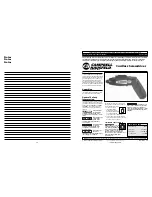
www.pulsar.pl
EN54-3A28
RED POWER
30
7. Reserve power supply circuit.
The PSU is fitted with intelligent circuits: battery charging circuit with the function of the accelerated
charging and battery control, which main task is to monitor the condition of the batteries and the connections in the
circuit.
If the controller detects a power failure in the battery circuit, appropriate indication and activation of the APS
FLT and ALARM technical outputs takes place.
7.1. Battery detection.
The control unit of the PSU checks the voltage at the battery terminals and, depending on the measured
values, determines the appropriate reaction:
U
BAT
below 4V - batteries not connected to the PSU circuits
U
BAT
= 4 to 20V - faulty batteries
U
BAT
over 20V - batteries connected to the PSU circuits
7.2. Protection against short-circuit of the battery terminals.
The PSU is fitted with the circuit protecting against short-circuit of the battery terminals. In case of short
circuit, control circuit immediately disconnects the batteries from the rest of the power supply circuit, so the loss of
output voltage on power supply outputs is not observed. Automatic reconnection of the batteries to the PSU's
circuits is only possible after the removal of the short-circuit and correct connection of the circuits.
7.3. Protection against reverse battery connection.
The PSU is protected against reverse connection of the battery terminals. In case of incorrect connection,
the F
BAT
fuse in the battery circuit becomes blown. The return to normal operation is possible only after replacing
the fuse and correct connection of the batteries.
7.4. Deep discharge battery protection UVP.
The PSU is fitted with the disconnection system and the battery discharge indication. If the voltage at
the battery terminals drops below 20V±0.2V during battery-assisted operation, acoustic indication will be activated
and the batteries will be disconnected within 15s.
The batteries are reconnected to the power supply unit automatically once the 230V AC mains supply is
restored.
7.5. Battery test.
The PSU runs battery test every 5 minutes. During testing, the control unit of the PSU measures the
electrical parameters according to the implemented measuring method.
A negative result occurs when the battery circuit continuity is interrupted, resistance in the battery circuit
increases above 300
mΩ or if the terminal voltage drops below 24V.
The battery test can be activated manually from the main menu (see section 6.3.1), for example to test the
replaced batteries.
The PSU is protected against too frequent performing of the battery test, which could result in
undercharging. The protection involves blocking the ability to perform test for 60 seconds from the last activation.
This function can be disabled by putting the Z2 jumper on the power supply board (Fig.2 [8]).
The battery test will also be automatically locked when the PSU is in the operating mode, in which the battery test
is impossible. Such condition occurs, for example, during battery assisted operation or when the power supply is
overloaded.
7.6. Measurement of the resistance of the battery circuit.
The PSU is checking the resistance in the battery circuit. During the measurement, the PSU driver takes
into account the key parameters in the circuit,
and once the limit value of 300m ohms is exceeded, a failure is
indicated .
A failure may indicate considerable wear or loose cables connecting the batteries.









































